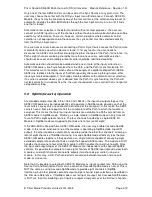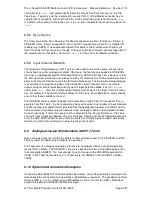
Prism Sound ADA-8XR Multi-channel A/D D/A Converter Module Reference - Revision 1.01
© Prism Media Products Limited, 2001-2005
Page 3.19
Only one of the four AES3 carriers can be used as the Sync Source at any given time. The
user may choose the carrier with the DI Sync Input menu (Preferences). For each AES3 I/O
Module, the sync may be fixed at any one of the four carriers, or the selection may be set to
automatic, whereby the ADA-8XR rotates through the four input carriers in turn until it finds
one that is locked.
Automatic carrier selection is the default and will suffice for most purposes - the user can
connect an AES3 input to any of the channels without having to worry about which one will be
used for synchronization. There are, however, certain situations where automatic carrier
selection is not appropriate and in these cases the sync carrier must be selected explicitly
from the DI Sync Input menu.
One such cases arises because disconnecting a Path’s Sync Source causes the Path to mute
momentarily while a new Sync Source is found. If, for any reason, the user needs to
disconnect an AES3 carrier without disrupting the other channels of the Path (for instance, if a
Path’s eight channels are being shared by more than one session), automatic selection
should not be used, and a reliably-present carrier should be nominated explicitly.
Automatic selection should also be avoided when one or more of the input carriers to an
AES3 I/O Module is itself synchronized from the Path, and the Path is synchronized to ‘DI’.
This would occur, for example, when some of the outputs of a digital-to-digital Path (AES3-
AES3) are fed back into the inputs of that Path (possibly after passing through some other
input-synchronized equipment). Such loops create problems with automatic carrier selection -
if a carrier is selected whose sync is derived from the Path it is synchronizing, the Path will
not lock correctly. In situations like this, the user should select a sync carrier that is not part of
a dependency loop.
5.9 Split96 (two-wire) Operation
At extended sample rates (88.2, 96, 176.4 and 192kHz), the input and output stages of the
AES3 I/O Module may be independently set to operate in Split96 mode, whereby each of the
four carriers convey only one audio channel instead of the usual pair. In this mode, the AES3
carriers have a frame rate equal to half the sample rate of the Path to which the module is
assigned. This means that only four input channels are available to a Path sourced from an
AES3 module in Split96 mode. Similarly, a single module in Split96 mode can only transmit
four of a Path’s eight output channels. The four channels handled by a single AES3 I/O
Module in Split96 mode are mapped to channels one to four (out of eight).
If the ADA-8XR is fitted with two AES3 I/O Modules, the user may enable Cascade Split96
mode. In this mode, whenever one of the modules is operating in Split96 mode (input OR
output), the other module is automatically used to provide the other four channels, allowing a
total of eight channels of Split96 interfacing. Cascade Split96 mode effectively joins the two
AES3 I/O Modules together so they operate as a single module capable of conveying eight
extended sample rate audio channels on eight half-speed AES3 carriers. The module in DIO1
handles channels one to four while the module in DIO2 handles channels five to eight. Since
the input and output stages of the AES3 I/O Module are independent, with separate Split96
controls, it is possible for example to have eight channels of Split96 input (spread across both
modules), and eight channels of one-wire outputs (two channels per carrier) using one
module. In this way, a D-D Path can perform conversion between two-wire and one-wire
mode, or vice-versa.
Note that it is possible to select both AES3 I/O Modules as input or output for a Path using the
Source Port and Destination Port menus, even when Cascade Split96 mode is not set. This is
NOT the same as using Cascade Split96 mode to provide eight channels of Split96
interfacing, but rather provides parallel-output and per-channel input-selection as described in
the Firmware Reference. If Split96 mode is set for input or output, but Cascade Split96 mode
is NOT set, then this ‘doubling up’ of inputs or outputs simply acts over the first four channels.






























